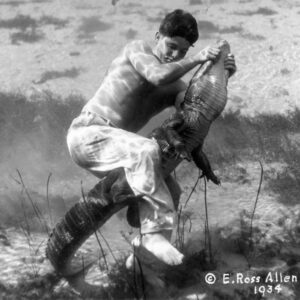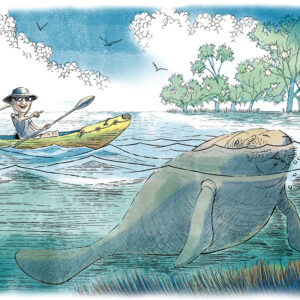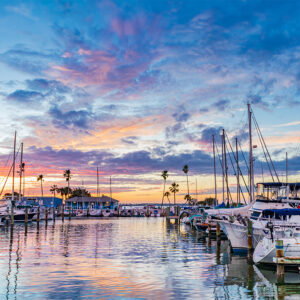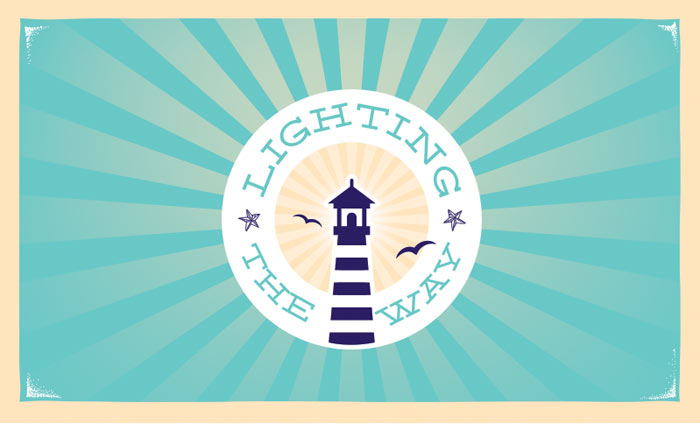
Most people think of Florida as a place to relax on sunny beaches. However, beyond those beaches, in the waters of the Gulf of Mexico, the Atlantic Ocean and the Straights of Florida are the treacherous seas that claimed many ships and lives until lighthouses split the darkness and led the way to port.
Photos courtesy of the Florida Lighthouse Association
Lighthouses offer a unique perspective on the world, whether you’re looking from the top of the tower or marking the shore with the signaling light. Paul Moon James (1780-1854) says it best, “And o’er them the lighthouse looked lovely as hope—that star of life’s tremulous ocean.”
At one time Florida had more than 60 lighthouses along its coasts. Today, there are around 30 active lighthouses that aid with navigation. The oldest is the St. Augustine Lighthouse, and the newest is Tierra Verde Lighthouse, which was lit in 2005.
The Florida Lighthouse Association is dedicated to making sure no more of these historical structures disappear.
“We are a group of citizen activists and historical professionals that pool our resources to work on the preservation and restoration of the remaining 30 historic lighthouses,” says Ken Smith, president of the group.
Information on all of Florida’s lighthouses is on our state’s official website, and the main mission is to secure resources for restoration.
“Our interest is preservation, and we put legs to that,” Smith says. “We have two grant programs, and we’re told we’re the easiest to apply for. We never turn an organization down. So far, when needs come up, we’re able to find funds.”
Though the familiar, conical tower is the most well-known design, it’s not the only structure for a lighthouse.
“Florida has just about every style of lighthouse that is known in the United States,” says John Mann, lead docent at Ponce de Leon Inlet Lighthouse in St. Augustine.
Because of the sandy or muddy soil, lighthouses are fixed on screw-pile foundations, where the iron supports are literally twisted deep into the ground.
In the Florida Keys and other remote areas, the lighthouses look like skeletons of the more-recognized towers but are actually more effective because wind and rain can pass through them without destroying the structure.
“The technology has evolved to the point where you can build them on land or in the water,” Mann says.
During the day, mariners identify lighthouses by the design and colors of the structure. At night, it’s the characteristics of the light. For example, the Pensacola Bay Lighthouse is a flash of white every 20 seconds, and the Tortugas Harbor Lighthouse flashes white every six seconds with one red sector.
The rating of the power of the lighthouse comes from how many nautical miles the light is visible. The Hillsboro Inlet Lighthouse has two million candlepower and can be seen from 25 miles out to sea, making it the most powerful in Florida.
But perhaps the most important element of a lighthouse is the lens for the light. The reason the light works the way it does is thanks to the work of Augustin-Jean Fresnel. An engineer and a physicist, he created a lens that was able to capture almost all of the light created by a flame. It was an amazing discovery that allowed light to be projected 20 miles or more.
The Fresnel lens resembles a beehive with a bulls-eye in the center, which, like a magnifying glass, makes the concentrated beam stronger. The beehive structure is created with rings of glass prisms that force the light into a single beam. Fresnel’s theory was proven by tests showing an open flame lost more than 90 percent of its light. When reflectors were used, the flame still lost more than 80 percent, but with the advances discovered with the Fresnel lens, less than 20 percent of the light was lost.
Although it may be difficult to explain in layman terms exactly how the lens works, a first-order (original) Fresnel is on display at the Lens Exhibit Building at Ponce Inlet. The huge lens came from the Cape Canaveral Lighthouse and was restored by a team of volunteers and museum staff.
“Ponce Inlet has some of the top experts on lenses in the world. If you wanted to build it from scratch, lenses are irreplaceable. Lenses are brought here from all over the world to be restored,” Smith says.
Perhaps the most important job related to historical lighthouses was that of the principal keeper. Because light was provided by flame, it was vital to have someone there to keep it fueled, often with whale oil or kerosene. Due to the high demands of the job, there was usually an assistant keeper and often a second assistant keeper. It wasn’t unheard of for a keeper’s wife to work with him, too, and being a lighthouse keeper was one of the few non-clerical jobs offered to women.
Before the advent of electricity, the lighthouse keeper’s work meant a 24-hour day. Duties included trimming the oil-lamp wick, polishing the lens and ensuring the revolving mechanisms were wound so the light kept turning.
In addition, the keeper monitored weather and made preparations if a storm was coming. Three of the 30 remaining lighthouses figure prominently in Florida history. Fortunately for us, they are open to the public and provide hands-on educational opportunities.
St. Augustine Lighthouse & Museum
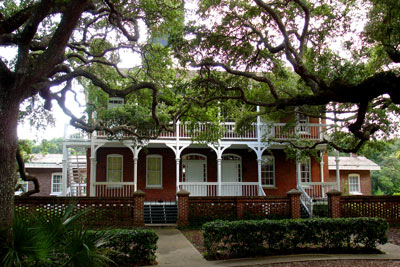
Exploration of St. Augustine, America’s oldest city, began in the mid-1500s, and a watchtower, built by the Spanish in the late 1500s, was replaced by an official lighthouse in 1876. The watchtower collapsed into the ocean during a storm in 1880. The lighthouse is St. Augustine’s oldest brick structure, features 219 steps to the top and stands 165 feet above sea level.
A lighthouse keeper and an assistant and their families occupied the living quarters until the lighthouse was automated in 1955.
The preservation of the lighthouse and its history is supported in a unique way, according to Shannon O’Neil, who is the museum’s public relations and graphics coordinator.
“Our museum does archeology research. We conserve artifacts, and we try to conserve the history of the people who worked here,” says O’Neil.
The Lighthouse Archaeological Maritime Program (LAMP) seeks to provide a better understanding of the maritime history of St. Augustine. It’s the nation’s oldest port, was considered the most dangerous port in all the British Atlantic colonies and was the site of many shipwrecks.
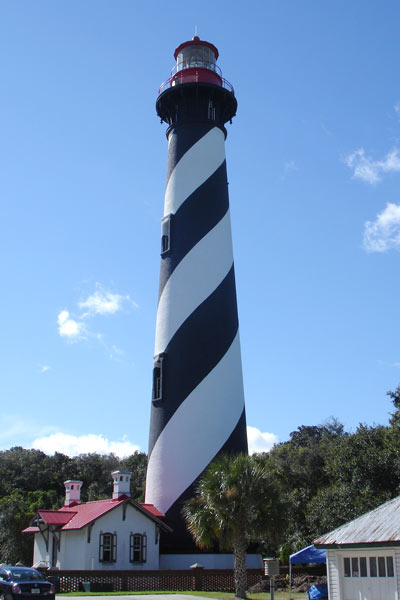
“Our archaeological team has recently been working with a shipwreck just off the coast of St. Augustine,” says O’Neil. “A 1782 British Loyalty ship. We’ve retrieved two cannons, some cannon balls, clothing irons and even shoe buckles. Whatever artifacts we find that can’t be used are returned to the ocean.”
The lighthouse is open daily from 9am to 6pm, except Thanksgiving and Christmas Days, and extended hours are available during holidays and summer months. Occasionally, weather will force the lighthouse to close. Hours are subject to change, and reservations may be required for some events. There are plenty of tour options available, including a popular paranormal activity tour.
100 Red Cox Rd., St. Augustine
(904) 829-0745
Pensacola Lighthouse & Museum
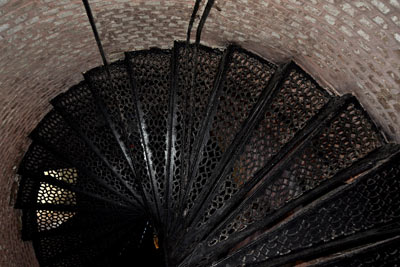
Though St. Augustine holds the title of America’s oldest city, Pensacola was home to the first American settlement.
In August 1559, 11 ships carrying goods and the belongings of more than 1,000 people came into the harbor for the last part of the journey to their new home. Disaster struck before they could get all the people and cargo off the ships. A hurricane hit the coast, sinking five of the ships and killing hundreds of people. The series of events that followed this catastrophe led to Western Florida being declared too dangerous for habitation for more than 100 years. Despite the early misfortune, Pensacola is still Florida’s second-oldest city and boasts the deepest bay on the Gulf Coast.
The lighthouse in Pensacola is located very close to the Naval air station.
“This is the home base of the Navy’s Blue Angels,” says Jon Hill, executive director for the Pensacola Lighthouse and Museum. “You can climb to the top and watch them practice, and they center their entire show on the lighthouse. You’re almost at eye level with the pilots. It’s the best place to watch the Blues.”
Those who enjoy having a little fun are fortunate, too.
“In October, we decorate the grounds and do a haunted house in connection with the Coast Guard. We use it to raise funds for the Coast Guard Relief Fund.”
Of course history is the main draw at this and most other lighthouses, and the Pensacola Lighthouse still has a very special piece of history on-site.
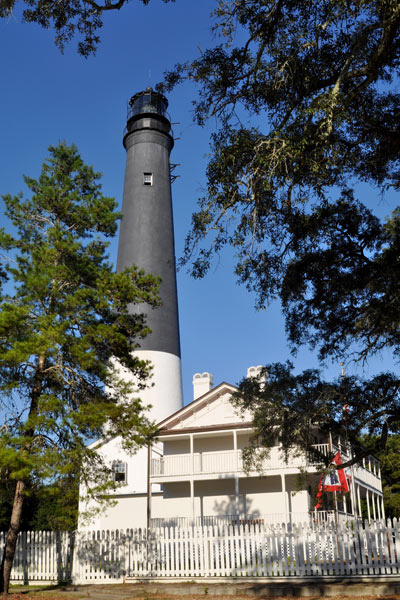
“We have our original first-order Fresnel lens,” says Hill. “We sit on a bluff and our light is the tallest light beam coming out of a lighthouse in Florida.”
Those planning a visit to the lighthouse should remember to wear good walking shoes. The Pensacola Lighthouse is 150 feet tall, and visitors climb 177 steps to the top. Now that’s a good workout!
Admission is $6 for adults and $4 for children under 12 and seniors 65 or older. Hours are 10am to 5:30pm Monday through Saturday and 12 to 5:30pm on Sundays. There are extended summer and holiday hours, and reservations may be required for some events.
2081 Radford Blvd., Pensacola
(850) 393-1561
Ponce de Leon Inlet Lighthouse & Museum
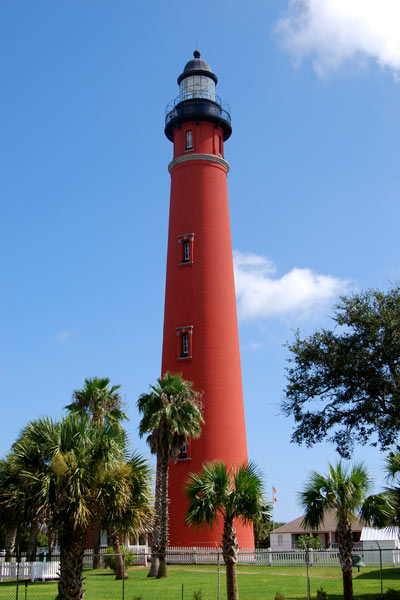
The lighthouse at Ponce de Leon Inlet is the tallest in Florida. Built in 1883, it’s 175 feet tall with 203 steps to get to the top. All the buildings in the compound are the original structures, including the keeper’s and assistant keeper’s houses.
“When you step into the interior of that picket fence, that’s exactly the way it looked 126 years ago. It’s not recreated, it’s exactly what it looked like all those years ago,” says John Mann, lead docent at Ponce de Leon Inlet.
The compound was a pleasant place to live for the keepers and their families, because unlike the keeper’s quarters in St. Augustine, where they all lived in one building, there were separate residences for each family at Ponce Inlet.
“We have a full-time curator and full-time staff,” says Mann. “The curator is Ellen Henry, and she has a lot of research and writing credits. She has been with us more than 12 years and is acknowledged across the nation as one of the top lighthouse preservation curators,” adds Mann. Though it was originally called Mosquito Inlet Lighthouse, the name was changed by the townspeople in 1927. Ponce de Leon came through the area in 1533, giving the town reason to honor him.
History surrounds you on the grounds of Ponce Inlet lighthouse. The kitchen garden that provided fresh vegetables for the families living there still contains heirloom plants. The principal keeper’s dwelling and the first assistant keeper’s dwelling provide a glimpse of how a typical home would have looked, and there are a number of artifacts on display in the principal keeper’s dwelling.
The first assistant keeper’s dwelling was named the Gladys Meyers Davis house because Davis was the last child to be born at the compound. Her father, Edward L. Meyer, was the last civilian principal keeper. Davis and her husband are still active volunteers at the lighthouse and come by almost every day.
Although education is the primary objective of the volunteers and staff, the lighthouse grounds are also the site of very important work. The staff and volunteers work with any other lighthouse in the world to restore historic lenses.
“We restore lenses for other lighthouses for free,” says Mann. “We’ve been as far as the Bahamas to help other lighthouses and societies, and I’ve visited 1,300 lighthouses worldwide. I do a lot of research myself, but I can always still learn.”
The lighthouse and museum are open to the public seven days a week from 10am to 6pm, with longer hours in summer through Labor Day. Admission is $5 for adults and $1.50 for children 11 and under. There are special admission rates for tours and educational group, and reservations may be needed.
4931 S. Peninsula Dr., Ponce Inlet
(386) 761-1821
ponceinlet.org
Lighthouse Lore
Built in 1825, the Cape Florida Lighthouse was set on fire during the Second Seminole War but was restored in 1846.
During the Civil War, lighthouses were used as lookout stations.
When it was discovered that boats and ships became more visible to German U-boats when the bright lights of lighthouses hit them, the Florida coast was darkened during World War II.
Located on Seahorse Key across the harbor from Cedar Key, though no longer functional, Cedar Key Lighthouse is used as a marine laboratory for University of Florida students. Built like a residential dwelling with the light mounted on top, it now serves as a dormitory for students involved in the study. It is open to the public only during designated open houses.
Though it’s listed as a faux lighthouse, the Mount Dora Lighthouse is the only registered inland navigation aid in the state.
Weathers Adages Followed by Lighthouse Keepers
Ring around the moon means rain soon.
If fleecy white clouds cover the heavenly way, the rain shall mar your plans that day.
Frost and dew in the morning shows no rain before the night.
Fish bite least with wind in the east.
Expect the weather to be fair when crows fly in pairs.
When ladybugs swarm, expect a day that’s warm.
Clear moon, frost soon.
Red sky at night, sailor’s delight. Red sky at morning, sailors take warning.
10 Oldest Lighthouses In Florida*
Amelia Island Lighthouse 1820
St. Augustine Lighthouse 1821
Garden Key/Tortugas Harbor Lighthouse 1824
Pensacola Lighthouse 1825
Cape Florida Lighthouse 1825
Key West Lighthouse 1825
St. Marks Lighthouse 1831
St. George Lighthouse 1833
Ponce de Leon Lighthouse 1835
Dog Island Lighthouse 1839
*Dates vary depending on source used. These dates are courtesy of the United States Coast Guard.
Sources: floridalighthouses.org, lighthousefriends.com, uslhs.org, lighthousepreservation.org, ponceinlet.org, pensacolalighthouse.org, staugustinelighthouse.com, lighthousedigest.com, hillsborolighthouse.org, thevillageslighthousegroup.weebly.com

